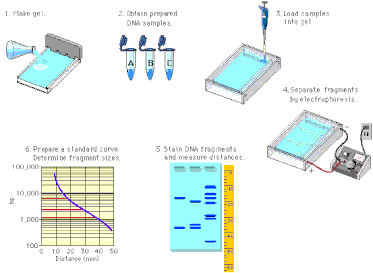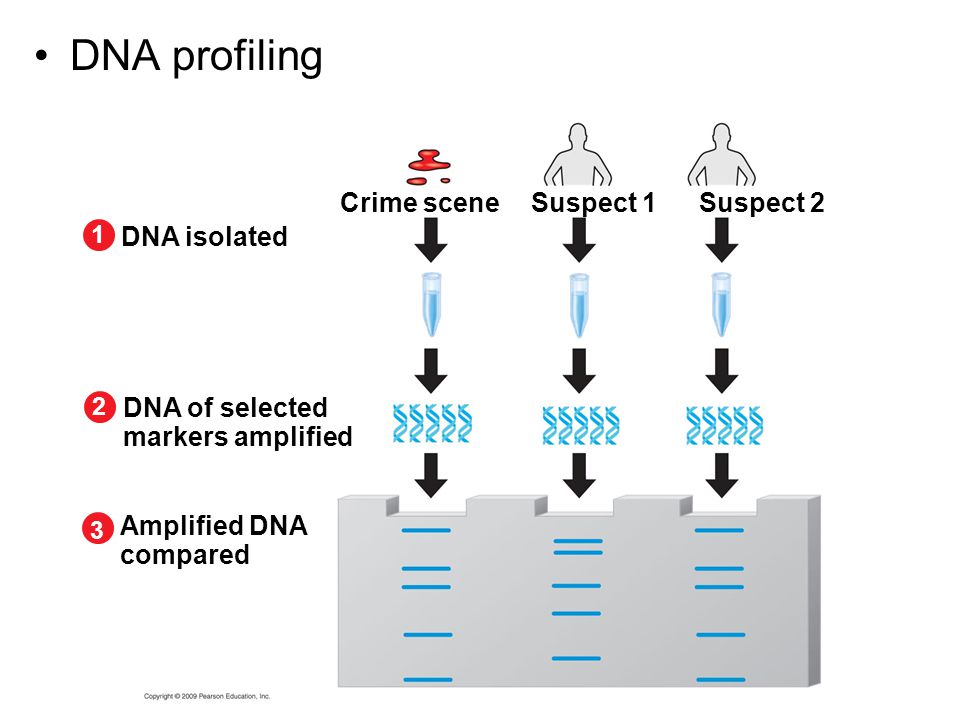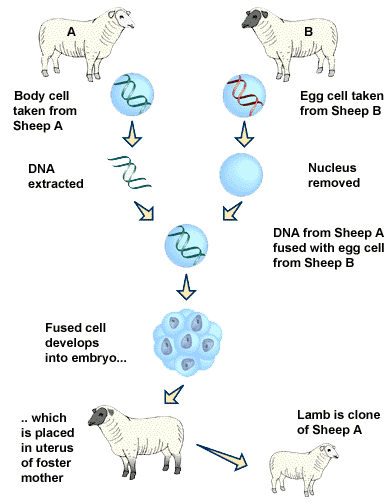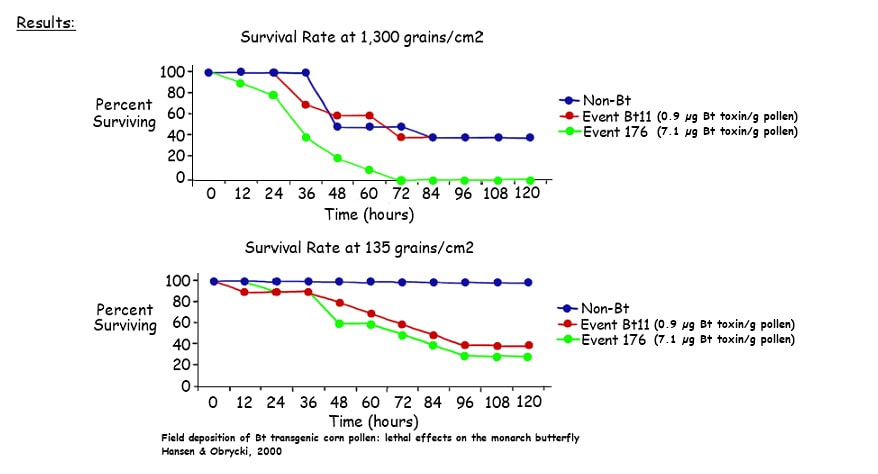topic 3.5 Genetic modification and biotechnology

In the DNA Biotechnology unit students are apply their learning of DNA structure to biotechnological applications. DNA electrophoresis, sequencing and databases are studied.
The unit is planned to take 3 school days
The unit is planned to take 3 school days
Essential idea:
- Biologists have developed techniques for artificial manipulation of DNA, cells and organisms.
Nature of science:
- Assessing risks associated with scientific research—scientists attempt to assess the risks associated with genetically modified crops or livestock. (4.8)
Understanding:
3.5.U1 Gel electrophoresis is used to separate proteins or fragments of DNA according to size. (Oxford Biology Course Companion page 187).
- Match restriction enzyme names to the bacteria in which they are naturally found.
- Describe the role of restriction enzymes in nature and in biotechnology applications.
- Contrast sticky vs. blunt ends.
- Determine the number and size of DNA fragments after being exposed to restriction enzymes (both linear and plasmid DNA).
- Demonstrate accurate use of a micro-pipette.
- Explain the function and purpose of DNA electrophoresis.
- Describe how and why DNA fragments separate during electrophoresis.
- Outline the functions of the buffer, marker and loading dye in DNA electrophoresis.
In gel electrophoresis DNA fragments move in an electric field and separate from each other according to their sizes. The smallest fragments will move the farthest distance from the origin of the DNA sample.
Stages of PCR
PCR occurs in a thermal cycler and uses variations in temperature to control the replication process via three steps:
- separates charged molecules in an electric field according to size and charge
- samples are in wells cast in a gel that’s immersed in a conducting fluid with applied electric field
- molecules with negative and positive move in a opposite directions, so proteins are separated according to their charge
- DNA molecules are too long to move therefore must be broken into smaller fragments
Stages of PCR
PCR occurs in a thermal cycler and uses variations in temperature to control the replication process via three steps:
- Denaturation – DNA sample is heated to separate it into two single strands (~95ºC for 1 min)
- Annealing – DNA primers attach to the 3’ ends of the target sequence (~55ºC for 1 min)
- Elongation – A heat-tolerant DNA polymerase (Taq) binds to the primer and copies the strand (~72ºC for 2 min)
3.5.U2 PCR can be used to amplify small amounts of DNA. (Oxford Biology Course Companion page 188).
- State the function of the PCR.
- Describe the selectivity of the PCR
Gel electrophoresis is a laboratory technique used to separate and isolate proteins or DNA fragments based on mass / size
- Samples are placed in a block of gel and an electric current is applied which causes the samples to move through the gel
- This causes samples of different sizes to separate as they travel at different speeds
- PCR – polymerase chain reaction that makes large numbers of copies of DNA can use PCR for forensic investigations
- PCR is used to copy specific DNA sequences by using a primer that binds
3.5.U3 DNA profiling involves comparison of DNA. (Oxford Biology Course Companion page 189).
- Outline the process of DNA profiling.
DNA profiling involves the use of PCR and gel electrophoresis of DNA
Forensics: DNA fingerprinting for criminal cases
- sample of DNA is obtained
- copied DNA is split into fragments using restriction endonucleases
- fragments separated by gel electrophoresis
- compared to see which bands are the same and which are different
Forensics: DNA fingerprinting for criminal cases
- collect samples of DNA-containing substance (blood, semen)
- from suspect
- from crime scene
- amplify quantity using PCR if necessary
- add endonucleases to produce DNA RFLPs
- use gel electrophoresis to separate RFLPs into DNA fingerprint
- compare samples from crime scene and suspect for match
- collect samples of DNA-containing substance (blood, semen)
- from children
- from suspected father
- amplify quantity using PCR if necessary
- add endonucleases to produce DNA RFLPs
- use gel electrophoresis to separate RFLPs into DNA fingerprint
- compare samples from children and suspected father for matching RFLP patterns
3.5.U4 Genetic modification is carried out by gene transfer between species.
A gene determines a particular trait by encoding for a specific polypeptide in a given organism. Because the genetic code is (almost) universal, an organism can potentially express a new trait if the appropriate gene is introduced into its genome. The transfer of genes between species is called gene modification, and the new organism created is called a transgenic. When genes are transferred between species, the amino acid sequence translated from them is unchanged – the same polypeptide is produced. Genes are transferred from eukaryotes –> bacteria
- Example – goats produce that secrete milk containing spider silk protein – spider silk is immensely strong but spiders could not be used to produce it commercially
- GM crops
- Example of GM crops – golden rice involved the transfer of three genes
3.5.U5 Clones are groups of genetically identical organisms, derived from a single original parent cell. (Oxford Biology Course Companion page 195).
- Contrast sexual and asexual reproduction.
- Define clone and cloning.
- Describe different ways in which natural clones can arise.
Clones are groups of genetically identical organisms or a group of cells derived from a single original parent cell
3.5.U6 Many plant species and some animal species have natural methods of cloning. (Oxford Biology Course Companion page 196).
Clones are groups of genetically identical organisms that are derived from a single original parent cell. Cloning is the process through which these identical organisms are produced. The size of clones can range from two (i.e. identical twins) to hundreds (i.e. crops of commercially grown plants).
Organisms that reproduce asexually, which results in genetically identical organisms. Sexual reproduction produces genetically different organisms as a result of gamete fusion.
Binary Fission
Budding
Fragmentation
Parthenogenesis
Plant Cloning Methods
Human Cloning Methods
Organisms that reproduce asexually, which results in genetically identical organisms. Sexual reproduction produces genetically different organisms as a result of gamete fusion.
Binary Fission
- The parent organism divides equally in two, so as to produce two genetically identical daughter organisms
- This method of cloning occurs in Planaria (flatworms) but is also common to bacteria and protists (e.g. euglena, amoeba)
Budding
- Cells split off the parent organism, generating a smaller daughter organism which eventually separates from the parent
- This method of cloning occurs in Hydra but is also common to many species of yeast
Fragmentation
- New organisms grow from a separated fragment of the parent organism
- This method of cloning is common to starfish and certain species of annelid worms
Parthenogenesis
- Embryos are formed from unfertilised ova (via the production of a diploid egg cells by the female)
- This method of cloning occurs in certain species of insect, fish, amphibians and reptiles
Plant Cloning Methods
- Plants have the capacity for vegetative propagation, whereby small pieces can be induced to grow independently
- This is because adult plants possess meristematic tissue capable of cellular differentiation (totipotent)
- Virtually all types of roots and shoots are capable of vegetative propagation
- Garlic and onion bulbs are modified plant leaves – all the bulbs in a group are genetically identical
- Underground stems (e.g. potato tubers) can form new plants which are genetically identical to the parent plant
- Certain plants can form horizontal stems called runners (or stolons) that grow roots and develop into clones
- Some plants (mainly algae, mosses and ferns) can reproduce asexually by producing spores
- Spores are also produced by certain types of bacteria and fungi
Human Cloning Methods
- Even human beings are capable of creating genetic clones through natural means
- Identical twins (monozygotic) are created when a fertilised egg (zygote) splits into two identical cells, each forming an embryo
- Non-identical twins (dizygotic) are created when an unfertilised egg splits into two cells and each is fertilised by a different sperm
- Identical twins will be clones of one another (genetically identical), while non-identical twins will share 50% of the same DNA
3.5.U7 Animals can be cloned at the embryo stage by breaking up the embryo into more than one group of cells. (Oxford Biology Course Companion page 198).
- Describe the process of reproductive cloning via embryo splitting.
- Outline example of cloning animal embryos via natural and artificial embryo splitting.
3.5.U8 Methods have been developed for cloning adult animals using differentiated cells. Oxford Biology Course Companion page 198).
- Describe the process of cloning via somatic cell nuclear transfer.
Cloning farm animals
- differentiated mammary cells extracted from parent sheep; grown in nutrient-deficient solution to stop the cell cycl
- undifferentiated egg cells extracted from egg donor; nucleus removed and discarded
- mammary cell placed next to enucleated egg cell
- electric shock causes two cell membranes to fuse, and mitosis to trigger
- mitotic division continues, producing embryo
- embryo implanted into surrogate mother
- after 5-month gestation, Dolly the lamb born with identical genotype to parent donating nucleus from mammary cell
Application
3.5.A1 Use of DNA profiling in paternity and forensic investigations. (Oxford Biology Course Companion page 189).
- List example sources of DNA that can be used in DNA profiling
DNA profiling involves the use of gel electrophoresis of DNA.
3.5.A2 Gene transfer to bacteria using plasmids makes use of restriction endonucleases and DNA ligase.
E. coli is used in gene technology because some of its DNA is found on plasmids (smaller circles of DNA). These plasmids can be removed and cleaved by restriction enzymes at target sequences. DNA fragments from another organism can also be cleaved by the same restriction enzyme, and these pieces can be added to the open plasmid and spliced together by ligase. The recombinant plasmids formed can be inserted into new host cells and cloned. When genes are transferred between species, the amino acid sequence of polypeptides translated from them is unchanged because the genetic code is universal.The basic technique in gene transfer is outlined below.
3.5.A3 Assessment of the potential risks and benefits associated with genetic modification of crops.
|
|
3.5.A4 Production of cloned embryos produced by somatic-cell nuclear transfer. Oxford Biology Course Companion page 199).
- Outline the production of Dolly the sheep using somatic cell nuclear transfer.
Somatic cell nuclear transfer is a method by which cloned embryos can be produced using differentiated adult cells. Somatic cells are removed from the adult donor and cultured (these cells are diploid and contain the entire genome). An unfertilised egg is removed from a female adult and its haploid nucleus is removed to produce an enucleated egg cell. The enucleated egg cell is fused with the nucleus from the adult donor to make a diploid egg cell (with the donor’s DNA). An electric current is then delivered to stimulate the egg to divide and develop into an embryo. The embryo is then implanted into the uterus of a surrogate and will develop into a genetic clone of the adult donor

Artificial Embryo Twinning
Somatic Cell nuclear Transfer
- Low-tech version of cloning which mimics the natural processes of producing identical twins
- An egg is fertilized by sperm
- In the early stages of its formation, the embryo is split into individual cells
- Then placed in a in a surrogate to grow to a full organism
- The resulting offspring produced are identical
Somatic Cell nuclear Transfer
- Egg cell nucleus is removed and replace by the nucleus of a somatic cell (e.g. skin cell)
- Under certain conditions, the egg begins to replicate as though it was a fertilized embryo
Skill
3.5.S1 Design of an experiment to assess one factor affecting the rooting of stem-cuttings.
A stem cutting is a separated portion of plant stem that can regrow into a new independent clone via vegetative propagation
There are a variety of factors that will influence successful rooting of a stem cutting, including:
- All stems possess nodes, from which a leaf, branch or aerial root may grow – the region between nodes are called internodes
- Stem cuttings are typically placed in soil with the lower nodes covered and the upper nodes exposed
- Stem cutting is a common method employed to rapidly propagate plant species (including sugar cane, grapes and roses)
There are a variety of factors that will influence successful rooting of a stem cutting, including:
- Cutting position (whether cutting occurs above or below a node, as well as the relative proximity of the cut to the node)
- Length of cutting (including how many nodes remain on the cutting)
- Growth medium (whether left in soil, water, potting mix, compost or open air)
- The use and concentration of growth hormones (e.g. IAA, IBA and NAA promote the formation of adventitious roots)
- Temperature conditions (most cuttings grow optimally at temperatures common to spring and summer)
- Availability of water (either in the form of ground water or humidity)
- Other environmental conditions (including pH of the soil and light exposure
3.5.S2 Analysis of examples of DNA profiles. (Oxford Biology Course Companion page 190).
- Analyze a DNA profile to determine relatedness or forensic guilt.
3.5.S3 Analysis of data on risks to monarch butterflies of Bt crops.
- Bacillus thuringienis (Bt) cor, is a transgenic plant, contains Bt gene encording CryIAb protein toxin
- Developed to suppress the European corn borer larvae (i.e. target organism) that feeds on the pollen grains that accumulate on corn leaves
- Also has unintended effects on species (e.g. monarch butterfly larvae; non-target organism) beyond transgenic field borders
- Feeds on milkweed plant but also ingests wind-dispersed pollen that has landed on the leaves
- The pollen contains the expensed insecticidal toxins of th eBt gene that kills monarch larva.
- Transgenic Bt corn pollen has a negative effect on effect on monarch butterfly larvae feedling next to Bt corn fields
- Both concentrations of pollen (i.e. amount of Bt gene toxin) decreased larval survival rates
- 1,300 grains/cm2 had lower survival rate than the 135 grains/cm2
- Therefore, higher concentrations of Bt gene toxin decreased larval survival rates
- Wind-dispersed pollen containing Bt gene toxin can cause larval mortality
- e.g. Event 176 pollen causes larval mortality in non-Bt plants
Key Terms:
|
bioinformatics
buffer DNA DNA profile DNA sequencing therapeutic cloning endonucleases differentiated cell recombinant DNA linear DNA sexual |
DNA stain
electrophoresis enzymes ethanol extraction forensics sticky end undifferentiated cell transgenic buffer asexual |
genome
loading dye polymerase plasmid insulin DNA ligase embryo somatic cell loading dye stem cutting |
microliter palindrome
PCR pipette paternite cloning bioreactor plasmid plasmid DNA blunt ends nuclear transfer |
restriction enzyme
restriction site electophoresis genentic modified crops genetic modification restriction enzyme transgenic gene transfer micro-pipette DNA fragments reverse transcriptase |
Class Materials:
Review DNA/Nucleic Acids Webquest
The Biology Project. Click on Human Biology. Work through DNA Forensics 1 and 2
Modeling Recombinant DNA.
Bill Nye Human Cloning Video
Cloning Times" You Have Come A Long Way Dolly" Activity
Let's Cloning a Mouse" activity
DNA extraction lab
Mystery gene instructions
Mystery gene site finder challenge
Mystery gene sequences
Mystery gene site finder key
How electrophoresis works reading
Modeling electrophoresis activity
Analyzing electrophoresis practice
Crime scene electrophoresis lab procedure
Topic 3.5 Review
Review DNA/Nucleic Acids Webquest
The Biology Project. Click on Human Biology. Work through DNA Forensics 1 and 2
Modeling Recombinant DNA.
Bill Nye Human Cloning Video
Cloning Times" You Have Come A Long Way Dolly" Activity
Let's Cloning a Mouse" activity
DNA extraction lab
Mystery gene instructions
Mystery gene site finder challenge
Mystery gene sequences
Mystery gene site finder key
How electrophoresis works reading
Modeling electrophoresis activity
Analyzing electrophoresis practice
Crime scene electrophoresis lab procedure
Topic 3.5 Review
Powerpoint and Notes on Topic 3.5 from Chris Payne
Your browser does not support viewing this document. Click here to download the document.
Your browser does not support viewing this document. Click here to download the document.
Correct use of terminology is a key skill in Biology. It is essential to use key terms correctly when communicating your understanding, particularly in assessments. Use the quizlet flashcards or other tools such as learn, scatter, space race, speller and test to help you master the vocabulary.
Useful Links:
Cycle sequencing
DNA restriction
Sanger sequencing
Paternity Testing Plasmids, Restriction Digestion, DNA gels
Gene Technology
BLAST search
Polymerase Chain Reaction
PCR
PCR
Scientist for Better PCR
Very visual from Dolan DNA Learning Centre
McGraw Hill step-through
Sequence For Yourself
Gel Electrophoresis
DNA Sequencing
Click here for an animation of Plant Gene Transfer.
Plasmid Cloning
Polymerase Chain Reaction, Recombinant DNA, Cloning
Gel Electrophoresis and DNA Profiling (or DNA Fingerprinting)
Gel electrophoresis
In-depth look from DNAi
DNA Learning Centre’s Electrophoresis animation
Learn.Genetics super-flashy animation
Case study: the case of the pothunters from Learn.Genetics
DNA transformation
Genetically Modified Organisms
Gene Gun
Genetic Engineering of Insulin
Recombinat DNA Technology
The Human Genome Project
The Human Genome Project animations
Official Site How to sequence a genome
Teachers’ resources
Outcomes: Bioinformatics DNA Microarrays 1 (2)
Gene Transfer Technology
McGraw Hill animation collection
Steps in cloning a gene, from McGraw Hill
NewScientist: gene therapy success reverses blindness
Gene Therapy in SCID (severe combined immunodeficiency) from Sumanas
Positive news about gene-transfer successes in SCID treatment, from Nature.
Gene transfer in insulin production from abpi schools
Genetic Modification in Crops and Animals
Glowing pigs and fish: Animal Farm TV series
GM food and you (objective, worth watching)
David Suzuki talks about GMO and the precautionary principle. For more about the precautionary principle, refer to 5.2 Greenhouse Effect.
Good extract from The Geek Manifesto by Mark Henderson on GMO’s and protestors.
Here is an interesting, if superficial, infographic on why we need more robust crops in many regions of the world. Your challenge – find out how these crops are modified and produced.
In the News:
Scientists to sequence genomes of hundreds of newborns (2013-09-04)
Will Sequencing Your Genes Change The Way You Live — And Die? (2013-09-13)
Engineered Golden Rice May Be Planted Soon In Philippines (2013-08-06)
GM rice delivers antibodies against deadly rotavirus (2013-08-09)
What's Up With That, Doc? Researchers Make Bunnies Glow (2013-08-15)
On voters’ plates: genetically engineered crops (2013-08-12)
Activists Destroy 'Golden Rice' Field Trial (2013-08-09)
Gene therapy treats children with rare diseases (2013-08-10)
Scientists Condemn Destruction of
Golden Rice Field Trial (2013-08-15)
Are Engineering Foods Evil? (article preview only, 2013-08-25)
Engineered bacterium hunts down pathogens (2013-09-11)
Owner of John Lennon's tooth hopes to clone the late Beatle (2013-08-22)
BBC News Kickstarter crowd gives glowing plant the green lights
But do GM crops encourage resistance and increased pesticide and herbicide use? from the Guardian.
This article from oneinsevenpeople outlines the use of GM mosquitoes in fighting dengue. But is there a serious knowledge gap standing in our way?
How GM Mosquito work
Download this Stem Cell cribsheet from SEED Magazine
Therapeutic cloning cures Parkinsons mice
News: Dolly team Scientists clone human brain cells, from the Guardian
More about cloning from ActionBioscience
Extinct Pyrenrean Ibex cloned back into existence – for seven minutes.
US says genes should not be patented, from the NY Times
Video Clips:
Paul Andersen describes the process of DNA fingerprinting and DNA profiling. He explains how variability in STRs can be used to identify individuals. He explains the importance of DNA fingerprinting in forensics and paternity cases
PCR is a process of amplifying the target DNA sequence using Taq DNA polymerase and a set of primers. This whole process is conducted in a thermocycler machine also known as a PCR machine that repeatedly changes temperature cycles to complete the process of DNA amplification.
Explore electrophoresis with The Amoeba Sisters! This biotechnology video introduces gel electrophoresis and how it functions to separate molecules by size.
Restrictive Enzymes
Gene Therapy
Genetic Modifications
As Chair of the Department of Agronomy, head of the Department of Genetics and Biotechnology at the Biotechnical faculty, University of Ljubljana, Borut Bohanec possesses a broad overview of classical and modern techniques of plant breeding. For many years he has been following advances in the field of genetically modified organisms and wishes for better understanding of the issue among the general public.
This short clip from Science in Europe outlines the state of GM food in Europe and has a nice explanation of the precautionary principle (it fits better here than in the Greenhouse Effect unit).
In 1997, Scottish scientists revealed they had cloned a sheep and named her Dolly, sending waves of future shock around the world that continue to shape frontiers of science today.
Any molecular biologist will tell you that genetic engineering is tricky. But up until recently we might be witnessing a new age in human development.
Now that genetic engineering tools like CRISPR allow us to edit our genes, how will that impact human evolution going forward? Are designer babies or eugenics around the corner? Welcome to a world of nonrandom mutation and unnatural selection.
Scientist and community lab advocate Ellen Jorgensen is on a mission to explain the myths and realities of CRISPR, hype-free, to the non-scientists among us.
CRISPR gene drives allow scientists to change sequences of DNA and guarantee that the resulting edited genetic trait is inherited by future generations, opening up the possibility of altering entire species forever.

















